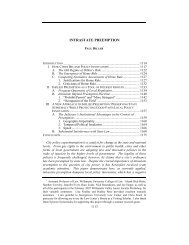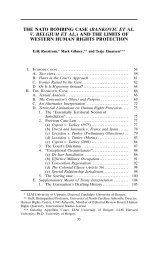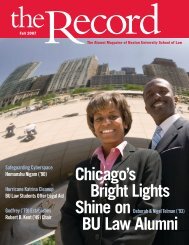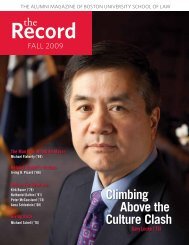the nature of representation: the cherokee right ... - Boston University
the nature of representation: the cherokee right ... - Boston University
the nature of representation: the cherokee right ... - Boston University
You also want an ePaper? Increase the reach of your titles
YUMPU automatically turns print PDFs into web optimized ePapers that Google loves.
120 PUBLIC INTEREST LAW JOURNAL [Vol. 15<br />
Georgia. 151 Ross should not be faulted for not clearly laying out a series <strong>of</strong><br />
propositions, for much <strong>of</strong> his work was consumed by his attempt to get <strong>the</strong> U.S.<br />
government to recognize its responsibilities under prior treaties concluded with <strong>the</strong><br />
Cherokees. Indeed, <strong>the</strong> limited Cherokee proposals—partial land concessions or<br />
out<strong>right</strong> land sale—ensure that <strong>the</strong> particular treaty articles represent <strong>the</strong> U.S. intent<br />
to a greater extent than <strong>the</strong>y represent Cherokee intent. Ironically, although<br />
initially a negative as far as <strong>the</strong> Cherokee were concerned, <strong>the</strong> limited Cherokee<br />
proposals mean that Cherokee calls for a Congressional delegate stand on firmer<br />
ground in that now <strong>the</strong> U.S. government cannot claim that <strong>the</strong> U.S. intent was not<br />
contained in <strong>the</strong> delegate provision. 152<br />
1. The Deputy Promise<br />
Article 7’s delegate <strong>right</strong> reflects a history <strong>of</strong> earlier promises that closely<br />
resemble it but fail to obligate <strong>the</strong> U.S. government in <strong>the</strong> same manner that<br />
Article 7 does. Therefore, Article 7 might best be understood for what it is not: it<br />
is not <strong>the</strong> lesser, similar, promises that preceded it. In 1778, <strong>the</strong> U.S. signed a<br />
treaty with <strong>the</strong> Delawares that included <strong>the</strong> following terms:<br />
And it is fur<strong>the</strong>r agreed on between <strong>the</strong> contracting parties should it for <strong>the</strong><br />
future be found conducive for <strong>the</strong> mutual interest <strong>of</strong> both parties to invite any<br />
o<strong>the</strong>r tribes who have been friends to <strong>the</strong> interest <strong>of</strong> <strong>the</strong> United States, to join<br />
151 Wilkinson and Volkman explain: “It is important to recognize that <strong>the</strong> American<br />
Indian’s treaty <strong>right</strong>s are not ‘gifts’ or ‘grants.’ Indians fought hard, bargained<br />
extensively, and made major concessions in return for such <strong>right</strong>s. Treaties can,<br />
<strong>the</strong>refore, properly be regarded as negotiated contracts <strong>of</strong> a high order.” Charles F.<br />
Wilkinson & John M. Volkman, Judicial Review <strong>of</strong> Indian Treaty Abrogation: “As<br />
Long as Water Flows or Grass Grows Upon <strong>the</strong> Earth”—How Long a Time is That?,<br />
63 CAL.L.REV. 601, 603 (1975).<br />
152 The terms in <strong>the</strong> New Echota treaty did not differ from those general terms which<br />
<strong>the</strong> U.S. treaty negotiator, Schermerhorn, was sent under Presidential authority to<br />
secure; consequently, <strong>the</strong> charge that Article 7 represents only Schermerhorn’s intent<br />
and not <strong>the</strong> intent <strong>of</strong> <strong>the</strong> U.S. government cannot be made. The Secretary <strong>of</strong> War’s charge<br />
to Schermerhorn and Governor Carroll, is indicative <strong>of</strong> <strong>the</strong> closeness between <strong>the</strong> U.S.<br />
intent and <strong>the</strong> treaty: “The provisional treaty contains <strong>the</strong> general terms which <strong>the</strong><br />
President is disposed to <strong>of</strong>fer to <strong>the</strong> Indians, and he is desirous that <strong>the</strong> Cherokee people<br />
should assent to this arrangement without making any change in its stipulations.”<br />
Letter from Lew Cass, Secretary <strong>of</strong> War, to J.F. Schermerhorn and Gov. William Carroll<br />
(Apr.2,1835),in TREATY WITH THE CHEROKEE INDIANS, 24th Cong., 1st Sess., 15-18, at<br />
15. Similarly, Schermerhorn’s journal reflects <strong>the</strong> crystallization <strong>of</strong> U.S. intent in <strong>the</strong><br />
terms agreed upon at New Echota: “I will only add that, in <strong>the</strong> o<strong>the</strong>r articles <strong>of</strong> <strong>the</strong><br />
treaty [including Article 7], no material alterations will be found from <strong>the</strong> propositions<br />
as originally drawn up.” A journal <strong>of</strong> <strong>the</strong> proceedings <strong>of</strong> <strong>the</strong> Council held at New<br />
Echota, Georgia Dec.21-30, 1835, with <strong>the</strong> Cherokee people by John F. Schermerhorn,<br />
Commissioner on <strong>the</strong> part <strong>of</strong> <strong>the</strong> United States to treat with <strong>the</strong> Cherokees east, in<br />
TREATY WITH THE CHEROKEE INDIANS, 24th Cong., 1st Sess., 20-27 at 24.









